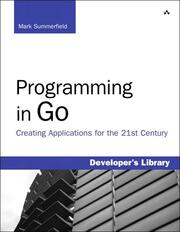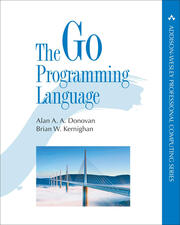Go is an open source programming language that makes it easy to build simple, reliable, and efficient software. -- https://golang.org/
- Go 1 and the Future of Go Programs (2012 or earlier)
It is intended that programs written to the Go 1 specification will continue to compile and run correctly, unchanged, over the lifetime of that specification.
Some exceptions, e.g. OS specific code, like syscall.
package main
import "fmt"
func main() {
fmt.Println("hello, world")
}Save code into a file, e.g. main.go - then:
$ go run main.go
- Go is a compiled, strongly typed, garbage-collected language. An executable lives in a package main and contains a function main as entry point.
All Go code is organized in packages.
Go code is organized into packages. Within a package, code can refer to any identifier (name) defined within, while clients of the package may only reference the package's exported types, functions, constants, and variables
A package in Go is simply a directory/folder with one or more .go files inside of it. -- https://rakyll.org/style-packages/
At import time, Go first look for packages in $GOROOT/src, which contains the
standard library (see Extra: Stdlib packages).
Depending on the project setup, e.g. GOPATH (early) or module-aware (current) code will be searched in GOPATH or the module cache.
There is no extra package manager - the go tool is used to install packages:
$ go install golang.org/x/tools/cmd/goimports@latest
[Go] get resolves its command-line arguments to packages at specific module versions, updates go.mod to require those versions, downloads source code into the module cache, then builds and installs the named packages.
You see go install a lot in READMEs. Caveat: as of 1.17 Using go get for
installing executables
deprecated.
These frictions come from mixed use cases with go get to fetch and build code
- and with the introduction of go modules, to also change the
go.modfile describing dependencies.
Go modules are the preferred way to start applications and libraries today.
To install executables on your system, run go install instead:
- without version suffix, if works on module level
- with version suffix (e.g. "@latest") it ignores modules
$ go install golang.org/x/tools/cmd/goimports@latest
Stack Overflow: What’s so great about Go?
- can be used for common problems (that e.g. scripting languages solve)
- can be used for performance critical code (as far as GC languages can be used)
- kind of resonates with software engineering today
- simple (kind-of)
- fast
In a regex test - regex-redux
Go is garbage-collected, yet fast - or fast enough for many use cases.
Anecdotal evidence: A simple, unoptimized reservoir sampling tool in Go is about twice as slow than a classic (most likely optimized) C tool.
-- miku/rsampling,
In short, development at Google is big, can be slow, and is often clumsy. But it is effective.
The goals of the Go project were to eliminate the slowness and clumsiness of software development at Google, and thereby to make the process more productive and scalable. The language was designed by and for people who write—and read and debug and maintain—large software systems.
Go's purpose is therefore not to do research into programming language design; it is to improve the working environment for its designers and their coworkers. Go is more about software engineering than programming language research. Or to rephrase, it is about language design in the service of software engineering.
-- https://talks.golang.org/2012/splash.article
A 2022 article: The Go Programming Language and Environment
Some bits:
Although the design of most languages concentrates on innovations in syntax, semantics, or typing, Go is focused on the software development process itself.
$ tree -d -I 'vendor|testdata|internal' /usr/local/go/src/
/usr/local/go/src/
├── archive
│ ├── tar
│ └── zip
├── bufio
├── builtin
├── bytes
├── cmd
│ ├── addr2line
│ ├── api
│ ├── asm
│ ├── buildid
│ ├── cgo
│ ├── compile
│ ├── cover
│ ├── dist
│ ├── doc
│ ├── fix
│ ├── go
│ ├── gofmt
│ ├── link
│ ├── nm
│ ├── objdump
│ ├── pack
│ ├── pprof
│ ├── test2json
│ ├── trace
│ └── vet
├── compress
│ ├── bzip2
│ ├── flate
│ ├── gzip
│ ├── lzw
│ └── zlib
├── container
│ ├── heap
│ ├── list
│ └── ring
├── context
├── crypto
│ ├── aes
│ ├── cipher
│ ├── des
│ ├── dsa
│ ├── ecdsa
│ ├── ed25519
│ ├── elliptic
│ ├── hmac
│ ├── md5
│ ├── rand
│ ├── rc4
│ ├── rsa
│ ├── sha1
│ ├── sha256
│ ├── sha512
│ ├── subtle
│ ├── tls
│ └── x509
│ └── pkix
├── database
│ └── sql
│ └── driver
├── debug
│ ├── dwarf
│ ├── elf
│ ├── gosym
│ ├── macho
│ ├── pe
│ └── plan9obj
├── embed
├── encoding
│ ├── ascii85
│ ├── asn1
│ ├── base32
│ ├── base64
│ ├── binary
│ ├── csv
│ ├── gob
│ ├── hex
│ ├── json
│ ├── pem
│ └── xml
├── errors
├── expvar
├── flag
├── fmt
├── go
│ ├── ast
│ ├── build
│ │ └── constraint
│ ├── constant
│ ├── doc
│ ├── format
│ ├── importer
│ ├── parser
│ ├── printer
│ ├── scanner
│ ├── token
│ └── types
│ └── fixedbugs
├── hash
│ ├── adler32
│ ├── crc32
│ ├── crc64
│ ├── fnv
│ └── maphash
├── html
│ └── template
├── image
│ ├── color
│ │ └── palette
│ ├── draw
│ ├── gif
│ ├── jpeg
│ └── png
├── index
│ └── suffixarray
├── io
│ ├── fs
│ └── ioutil
├── log
│ └── syslog
├── math
│ ├── big
│ ├── bits
│ ├── cmplx
│ └── rand
├── mime
│ ├── multipart
│ └── quotedprintable
├── net
│ ├── http
│ │ ├── cgi
│ │ ├── cookiejar
│ │ ├── fcgi
│ │ ├── httptest
│ │ ├── httptrace
│ │ ├── httputil
│ │ └── pprof
│ ├── mail
│ ├── rpc
│ │ └── jsonrpc
│ ├── smtp
│ ├── textproto
│ └── url
├── os
│ ├── exec
│ ├── signal
│ └── user
├── path
│ └── filepath
├── plugin
├── reflect
├── regexp
│ └── syntax
├── runtime
│ ├── cgo
│ ├── debug
│ ├── metrics
│ ├── msan
│ ├── pprof
│ ├── race
│ └── trace
├── sort
├── strconv
├── strings
├── sync
│ └── atomic
├── syscall
│ └── js
├── testing
│ ├── fstest
│ ├── iotest
│ └── quick
├── text
│ ├── scanner
│ ├── tabwriter
│ └── template
│ └── parse
├── time
│ └── tzdata
├── unicode
│ ├── utf16
│ └── utf8
└── unsafe
184 directories
The go tool covers many aspects of code life cycle, e.g. formatting, running, building, testing, linting code, etc.
There is an editor support page, the wiki contains a more comprehensive list:
For a good cross-platform experience, the Visual Studio Code and vscode-go (6M+ downloads currently).
Depending on your setup, I can recommend vim-go.
A huge project currently in development is gopls, the
official Go language server developed by the Go team
Mostly integrated into editor support: run go fmt and sorts out imports.
Install with:
$ go install golang.org/x/tools/cmd/goimports@latest
Note: Also go get works, but install is now recommended:
https://golang.org/ref/mod#go-get
Run go doc to get quick access to documentation.
usage: go doc [-u] [-c] [package|[package.]symbol[.methodOrField]]
Package docs:
$ go doc http
Specific symbol:
$ go doc http.RoundTripper
Current project.
$ go doc .
You'll need to run this in a directory with Go files, otherwise you might see a:
doc: no buildable Go source files in
Show full source:
$ go doc -src io.ReadCloser
package io // import "io"
// ReadCloser is the interface that groups the basic Read and Close methods.
type ReadCloser interface {
Reader
Closer
}
func NopCloser(r Reader) ReadCloser
The go doc tool does not come with ... support.
The package path must be either a qualified path or a proper suffix of a path. The go tool's usual package mechanism does not apply: package path elements like . and ... are not implemented by go doc.
For exploring a larger codebase:
- Jump back and forth to definitions (e.g.
CTRL-g d, "Go to definition", ...) - A call graph visualizer
Install go-callvis, then clone a repo you want to analyze:
$ go-callvis -file callgraph -format png -nostd \
-focus github.com/miku/microblob \
github.com/miku/microblob/cmd/microblob
A few picks from ref/spec.
Even if you do not see them typically, Go uses semicolons - they just get automatically inserted into the token stream.
You can name a variable αβ - first character in an identifier must be a letter.
Go treats all characters in any of the Letter categories Lu, Ll, Lt, Lm, or Lo as Unicode letters [...]
A rune is an alias for int32, representing a Unicode code point.
It is written with single quotes.
A rune literal is expressed as one or more characters enclosed in single quotes, as in 'x' or '\n'.
package main
import "fmt"
func main() {
a := 'a'
fmt.Printf("%T %c %d %x %v\n", a, a, a, a, a == 97)
fmt.Printf("%s %d\n", "a", len("a"))
v := '⧉'
fmt.Printf("%T %c %d %x %v\n", v, v, v, v, v == 10697)
// int32 a 97 61 true
// int32 ⧉ 10697 29c9 true
}More on format verbs: https://pkg.go.dev/fmt#hdr-Printing
More on that in https://blog.golang.org/strings.





